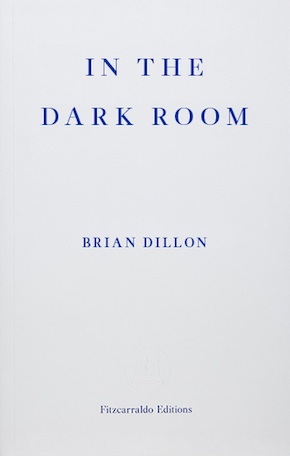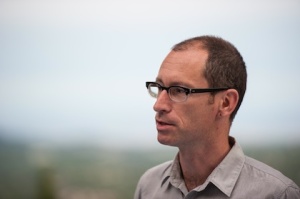Through the valley of shades
by Frances Wilson
“A wonderfully controlled yet passionate meditation on memory and the things of the past.” John Banville
In the Dark Room, originally published in 2005, is a meditation on mourning and an excavation of memory. It was also Brian Dillon’s first book, and we might see it as the prelude to his subsequent essays on photography and hypochondria, artists and ruins, essayists and what he calls ‘essayism’. How, Dillon asks, does memory – that “refined and slow-drying medium which covers everything” – adhere to ashtrays and snow globes, stairwells and hallways? The answer is explored through the catastrophe of his family life.
When he was fifteen, Dillon’s mother died of a rare autoimmune disorder and five years later his father suffered a fatal heart attack. “The double bulwark” of his parents’ deaths creates what Dillon describes as “a storehouse of memories all the more alluring for being glimpsed through the thick portal of mourning.” The world he returns to in these pages is “submerged”, settled in a “strange submarine resting place”, as though the objects and images contained here “could not survive in the corrosive air of a clear recollection.” In his Philosophical Enquiry into the Origin of our Ideas of the Sublime and Beautiful, Edmund Burke observed how “it is in the nature of grief to keep its object perpetually in its eye… to repeat all the circumstances that attend to it.” Dillon attends, with unflinching intensity, to the objects and circumstances of his grief, the ferocity of his intellect holding in check the seductions of elegy.
The book begins in 1993 with Dillon, aged twenty-four, leaving for the last time the semi-detached in Dublin where he and his brothers were born. The house is now empty, and “no house could be more comprehensively stocked with the detritus of the past than the empty house.” Many of Dillon’s memories are of last times: the last family holiday, his last look at his mother’s face, his last look at his father’s body, the last argument he had with his brothers. Hypochondria, from which he suffered, is equally focused on finality. “Nothing of the everyday,” Dillon explains of the gain from his condition, “can match the exhilaration of rebirth that seizes one when the imagined disorder fails to become real.” For that brief moment, he is not living in end time.
To guide him through the valley of shades, Dillon is accompanied by Roland Barthes, Jorge Luis Borges, Charles Baudelaire, John Berger, Gaston Bachelard, Henri Bergson and Walter Benjamin. His mind is cultivated in the soil of the twentieth century but seeded in British Romanticism – at least in Borges’s understanding of Romanticism as “a feeling of loss”. Barthes’s Camera Lucida and Proust’s À la recherche du temps perdu are the acknowledged precursors to In the Dark Room, but it is as a late Romantic that I read Brian Dillon. The high austerity of his project, the concern with ruins and the growth of his own mind, the return to childhood, the intimations of mortality all recall Wordsworth, who was also orphaned before he reached adulthood, whose writing was also born of loss. In The Prelude Wordsworth described himself as “conscious of myself / And of some other being” and this double consciousness is what Dillon also attends to in these pages, where he is both narrator and subject, patient and doctor, adult and child (the older Dillon has no sympathy for his younger version). He is moreover – and this is the most striking aspect of his prose – vigilantly present as a seeing eye and curiously absent as an ego. Dillon, who notices everything, is alert to his own disappearance: looking at photographs of himself, taken before the death of his mother, he sees in his form a solidity that has since vanished; he has “evanesced” through grief, to the point where he would now, he fears, fail to even register on film. But if Dillon is continually disappearing, he reappears in the bodies of his parents. In a photograph of his father aged seven, Dillon sees, “as if hovering below the surface”, his own unborn face. In appearance he is his father’s double, his living shade. After his mother’s death, Dillon’s skin began to stiffen, bristle and burn in a mirroring of her own horrific symptoms. Bodies, he notes, remember in their own way.
Dillon’s titles, like labels on boxes to be stored in the attic, describe his method: he accumulates, and then categorises chaos. He also freely associates, allowing one thing to lead him to another.”
Dillon describes memory as “a sort of space, in which are piled up… all manner of essential or useless objects.” He places these objects – pipes, pens, Bibles, churches and corner cabinets – in five chapters called ‘House’, ‘Things’, ‘Photographs’, ‘Bodies’ and ‘Places’. Dillon’s titles, like labels on boxes to be stored in the attic, describe his method: he accumulates, and then categorises chaos. He also freely associates, allowing one thing to lead him to another. In ‘House’ Dillon recalls Thomas De Quincey’s description, in Confessions of an English Opium Eater, of the auditory effect of the Whispering Gallery beneath the dome at St Paul’s Cathedral: “a word or question uttered at one end… in the gentlest of whispers, is reverberated at the other in peals of thunder.” For De Quincey, and also for Dillon, the progress of the whisper is a metaphor for memory: what at the start of a life seems of little impact speaks by the end “in volleying thunders”. In ‘Places’ Dillon turns to George Eliot’s description, in Middlemarch, of Dorothea Brooke’s honeymoon in Rome, where she wanders alone through St Peter’s. What “accosted” him in the passage, Dillon recalls, “is Eliot’s insistence on the way in which the interior of the church persists in Dorothea’s imagination”, and he now returns to the vast, Victorian monument in which the funerals of his parents took place. As a child he had once fainted here during family mass, and the church is as frightening as the hospital in which his mother is treated. Like one of Piranesi’s prisons, the church became “a void into which I used to feel I might fall: I would gaze, in distracted moments, at its upper reaches, and wonder what it would be like to drift towards the distant ceiling and hang there, looking down on the congregation below.” This suspended position, high in the vaults and looking down, is where Dillon can often be found. It is only when he confronts the consolations of Catholicism that his tone – always taut, occasionally tense – turns to rancorous anger. His father’s funeral “had exposed our ancient family secret: our affinity with this monstrous architecture, this unbearable weight of solid silence and droning piety, these poisonous clouds of incense and candle smoke.”
The dark room, where photographic negatives are developed into images, is Dillon’s central metaphor for memory. But the darkness he inhabits is occasionally illuminated by a lighthouse beam. In one such instance it is early morning; he is in bed, his mother is in hospital and his father, having just come off the telephone, is standing in the doorway speaking to him. “And the phrase which joins the feeble light from the doorway to the shaft of sunlight from behind the curtains at the other corner of the room is ‘She doesn’t have long.’” Dillon has many devastating sentences, but this is the one I cannot forget, that wounds me like the punctum of a photograph. He continues:
To wake in the night and find that the light from the opening above my bedroom door was once again stretched across the ceiling was in later years my greatest nocturnal fear. Like the lamp of a lighthouse which no longer turns but is stuck in a single, cyclopean beam of panic, it signalled a danger which would instantly be confirmed by a hushed voice or a footfall on the landing.
Dillon’s prose also stores memories, and contained in this scene is the footfall of another. When, in To the Lighthouse, Mrs Ramsey dies and the holiday house is abandoned, “certain airs… ventured indoors… Some random light directing them with its pale footfall upon stair and mat, from some uncovered star, or wandering ship, or the Lighthouse even.” De Quincey too, Dillon notes, associated death with light coming through a bedroom window, and he also mapped his grief onto the architectural spaces of the childhood home.
Wordsworth, De Quincey’s mentor, might have called Dillon’s “cyclopean beam of panic” a “spot of time”, one of those moments of imaginative convergence – like a naked pool, or a woman with a basket on her head – that penetrates the mind. The spot of time that contains the death of Dillon’s mother anticipates another spot of time, in the section called ‘Waiting Room’. Once again lying on his bed, Dillon is now told by his brother, standing at the door, that their father has died: “My father is dead. No, my mother is dead (I know because I was here: I lay here, in this room, on this bed, the morning after she died). But my father is dead too.” The reality of his loss is figured in the emptiness of the hall at the bottom of the stairs: “For the briefest moment, that space might have contained anything at all; the possibility of a grotesque mistake, of a violent or lingering death, or time turning away from the course to which I am trying to accommodate myself.” Hovering below the surface of these lines is the memory of the young Wordsworth in The Prelude, also waiting, also with his brothers, for the horses that will carry him from school to the home in which his father will also soon die.
It is De Quincey who gave us the metaphor of the human brain as a palimpsest, onto which “everlasting layers of ideas, images, feelings, have fallen… softly as light. Each succession has seemed to bury all that went before. And yet, in reality, not one has been extinguished.” In Dillon’s hands, De Quincey’s image converges, like the light from the doorway and the light from behind the curtains, with that of the Whispering Gallery. “Not only,” Dillon writes, “do the events of the past remain carved into the mind, but it is precisely the tiniest and faintest marks that will one day make their presence felt, magnified to monstrous, grotesque legibility.” It is the slow surfacing of these marks that Dillon makes visible in this extraordinary book, which itself remains carved in the mind.
Reproduced from the foreword to In the Dark Room by Brian Dillon by permission of Fitzcarraldo Editions
© Frances Wilson, 2018
 Brian Dillon, born in Dublin in 1969, is UK editor of Cabinet magazine and teaches at the Royal College of Art. His books include Essayism, The Great Explosion (shortlisted for the Ondaatje Prize), Objects in This Mirror: Essays, I Am Sitting in a Room, Sanctuary and Tormented Hope: Nine Hypochondriac Lives (shortlisted for the Wellcome Book Prize). In the Dark Room is out now from Fitzcarraldo Editions, priced £12.99. Read more
Brian Dillon, born in Dublin in 1969, is UK editor of Cabinet magazine and teaches at the Royal College of Art. His books include Essayism, The Great Explosion (shortlisted for the Ondaatje Prize), Objects in This Mirror: Essays, I Am Sitting in a Room, Sanctuary and Tormented Hope: Nine Hypochondriac Lives (shortlisted for the Wellcome Book Prize). In the Dark Room is out now from Fitzcarraldo Editions, priced £12.99. Read more
briangdillon.wordpress.com
@briangdillon
Author portrait © Chris Dixon
Frances Wilson is a biographer whose books include The Ballad of Dorothy Wordsworth and Guilty Thing: A Life of Thomas De Quincey. She teaches writing at Goldsmiths College, University of London.

